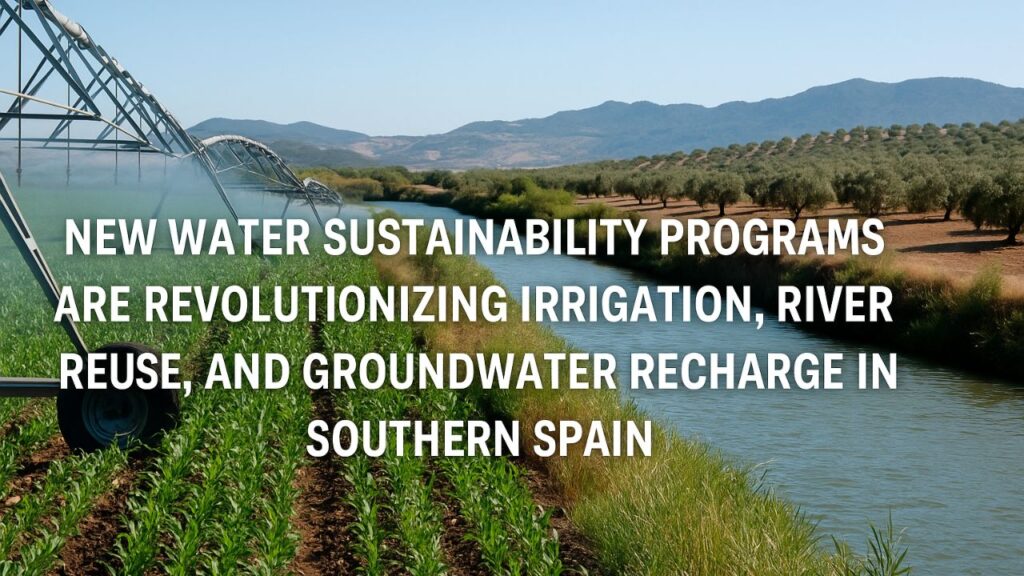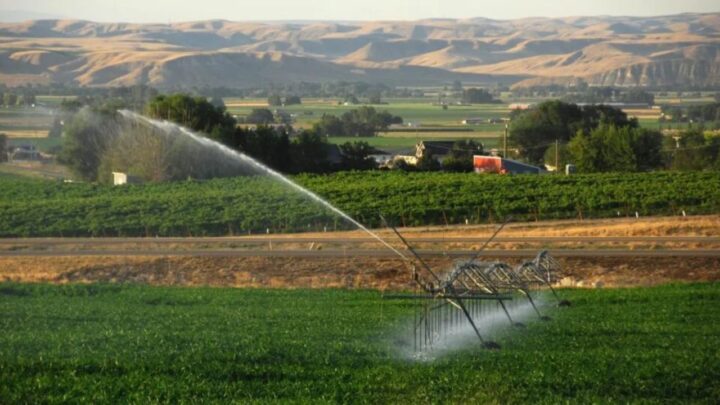New Water Sustainability Programs – Southern Spain, particularly regions like Andalusia and Murcia, has long struggled with chronic droughts and water scarcity. The region’s hot, semi-arid climate and heavy dependence on agriculture have placed significant strain on its limited water resources. However, a wave of groundbreaking water sustainability programs is transforming how water is sourced, used, and preserved across this drought-prone landscape. From cutting-edge irrigation systems to innovative river water reuse and groundwater recharge initiatives, Southern Spain is becoming a model for water management in arid zones.

Spain’s Water Crisis: The Need for Sustainable Solutions
Water scarcity in Southern Spain is not a recent issue—it has persisted for decades. Agricultural overuse, rising temperatures due to climate change, and outdated irrigation practices have only worsened the problem. According to recent EU reports, some parts of the region have experienced up to a 25% decrease in annual rainfall over the past 30 years.
To address these urgent challenges, local governments, EU agencies, and private stakeholders have partnered to develop sustainable water management models that focus on long-term conservation and smarter usage of available resources.
 Weekend Rain Alert September 2025 – Heavy Rainfall to Impact Several South African Regions
Weekend Rain Alert September 2025 – Heavy Rainfall to Impact Several South African Regions
Key Focus Areas of the New Sustainability Programs
The new water sustainability programs launched in 2024–2025 revolve around three core pillars: precision irrigation, river water reuse, and artificial groundwater recharge. Each initiative plays a crucial role in creating a circular and more efficient water economy.
1. Precision Irrigation Systems
Southern Spain is highly dependent on agriculture, particularly for olive trees, vineyards, citrus fruits, and vegetables. These crops consume large quantities of water, often applied inefficiently.
Improvements introduced:
- Use of smart drip irrigation controlled via sensors and IoT platforms
- Soil moisture monitoring systems to avoid overwatering
- AI-based crop water requirement predictions
- Subsidies for farmers to adopt water-efficient equipment
Benefits:
- Up to 40% water savings per hectare
- Increase in crop yield and quality
- Reduction in groundwater over-extraction
2. River Water Reuse and Recycling Plants
To deal with seasonal river flow fluctuations and pollution, Spain has introduced river water reuse plants that filter and clean surface water from rivers like the Guadalquivir, Segura, and Tinto for reuse in agriculture and municipal services.
Key Features:
- Advanced filtration and UV sterilization systems
- Recycled water used for farming, landscaping, and industrial cleaning
- Public-private partnerships with regional water utilities
Impact:
- Reduction in freshwater extraction from reservoirs
- Reuse of over 70% of treated water during peak farming season
- Compliance with EU Water Framework Directive
3. Groundwater Recharge via Artificial Aquifers
One of the most innovative projects involves injecting treated wastewater and surplus rainfall into underground aquifers to restore depleting groundwater reserves.
Program Highlights:
- Over 25 recharge wells built across Murcia and Almería
- Use of gravel and sand filtration before underground injection
- Monitoring of aquifer levels using remote sensing and geophysical sensors
Results:
- Recharge of over 50 million cubic meters of water in 2024 alone
- Stabilization of water table levels in high-risk zones
- Improved resilience during dry summer months
Success Stories from the Field
Farmers and municipalities across Southern Spain are already seeing dramatic changes:
Example 1:
- Region: Seville Province
- Change: Switched from traditional flood irrigation to drip systems
- Outcome: Saved 60% water and increased orange yield by 30%
Example 2:
- Region: Murcia
- Project: Groundwater recharge through stormwater collection
- Outcome: Revived a nearly depleted aquifer and helped 5 local farms stay operational during drought
Example 3:
 Youth Support Grant R12,500 September 2025 – Applicants Advised to Prepare Documents Early
Youth Support Grant R12,500 September 2025 – Applicants Advised to Prepare Documents Early
- Region: Almería
- Initiative: River water reuse system with dual pipelines for drinking and irrigation
- Outcome: Enabled consistent water supply for 700 hectares of farmland
Funding and Support for Water Programs
The financial backbone of these programs includes support from the European Union’s Horizon Europe research fund, Spain’s Ministry for the Ecological Transition, and international development banks.
Breakdown of Funding (2024–2025):
| Source | Contribution Amount (in €) | Purpose |
|---|---|---|
| EU Horizon Europe Fund | €100 million | Research and technology development |
| Spanish Government Grants | €65 million | Equipment subsidies for farmers |
| Public-Private Partnerships | €45 million | Infrastructure for recycling and recharge |
| Local Municipal Budgets | €20 million | Operations and maintenance of new systems |

Future Plans and Innovations
Spain is already planning phase two of the water sustainability programs, which include:
Expansion of Digital Twin Water Models
Digital simulation models will allow for better prediction of droughts and smarter allocation of water across municipalities.
Community-Level Water Cooperatives
New legislation is in the works to form local water cooperatives that allow small farmers to pool and share water efficiently.
Integration with Solar Energy
Pilot programs are testing solar-powered irrigation pumps and water recycling systems to lower carbon emissions and operating costs.
Eco-Education and Public Awareness Campaigns
Schools and communities are being educated on water conservation through gamified apps and interactive workshops.
Southern Spain’s multi-pronged approach to water sustainability is becoming a global benchmark for managing scarce water resources. With a smart combination of technology, policy, and community involvement, these programs are not only reviving Spain’s agricultural heartland but are also ensuring long-term environmental health for future generations.
If these models continue to succeed, they could be replicated in other drought-hit regions across the Mediterranean, Africa, and even California—where similar water challenges persist.
FAQs
Q1. What is precision irrigation and how does it help save water?
Precision irrigation uses sensors, IoT, and AI to deliver exact amounts of water needed by crops, preventing overuse and boosting efficiency.
Q2. How is river water reused for agriculture?
River water is treated in recycling plants using filtration and UV methods, then redirected for farming, cleaning, and landscaping purposes.
Q3. What is groundwater recharge and why is it important?
Groundwater recharge involves injecting treated water or rainwater into underground aquifers to restore falling water tables, essential for long-term supply.
Q4. Are farmers receiving any support to switch to new systems?
Yes, the Spanish government and EU are offering subsidies and grants to help farmers upgrade to modern, water-efficient technologies.
Q5. Can these Spanish water models be used in other countries?
Absolutely. These models are especially suitable for drought-prone areas and are being considered by policymakers in Italy, Greece, and parts of the U.S.



